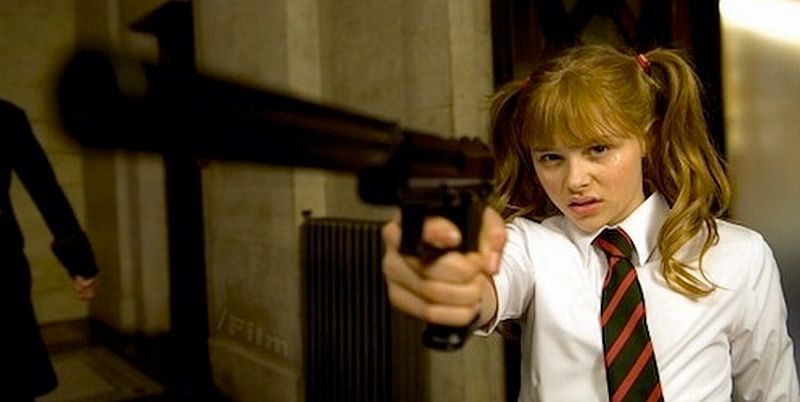
I’ve noticed a clear trend over the past couple of years for action-heroines to skew younger. Both of the principal 2011 genre entries to date, Sucker Punch and Hanna have featured heroines who aren’t old enough to drink, particularly in the latter’s case. One of the most anticipated films, currently in pre-production, is The Hunger Games, in which a 16-year old girl is press-ganged into a fight to the death, against other teenagers. But we’ve seen examples previously too, notably in last year’s Kick-Ass, where a foul-mouthed moppet stole the film in many people’s eyes, albeit not without causing a great deal of controversy.
Let’s review these, and some other entries in the sub-genre, both historical and fictional. You can find them all the way back to the seventh century, such as China’s Princess Pingyang, who was born in 598, and was instrumental in raising and leading an army of 70,000 men in a successful rebellion against the Emperor Yang, before reaching her twentieth birthday. This helped establish her father as the first Emperor of the Tang dynasty, often regarded as a high-point of Chinese civilization. We can perhaps file Mulan in this category too, though the poem does not assign her a specific age.
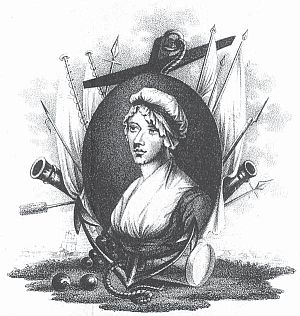 Joan of Arc was perhaps the first world renowned teenage action-heroine. She led the French army at the age of 16 or 17, lifting the siege of Orleans and turning the course of the Hundred Years’ War in France’s favour, though it rumbled along for decades more. A little later in French history, Jeanne Laisné, known as Jeanne the Hatchet after a crucial role in preventing the capture of Beauvais by the Duke of Burgundy. Many countries have their own “Joans”, and sher may well have been an inspiration for Maria Rosa, a 15-year old girl who claimed divine visions and led a rebel army during the Brazilian Contestado War around 1914.
Joan of Arc was perhaps the first world renowned teenage action-heroine. She led the French army at the age of 16 or 17, lifting the siege of Orleans and turning the course of the Hundred Years’ War in France’s favour, though it rumbled along for decades more. A little later in French history, Jeanne Laisné, known as Jeanne the Hatchet after a crucial role in preventing the capture of Beauvais by the Duke of Burgundy. Many countries have their own “Joans”, and sher may well have been an inspiration for Maria Rosa, a 15-year old girl who claimed divine visions and led a rebel army during the Brazilian Contestado War around 1914.
Around the year 1660, we find the lyrically-named Görwel Christina Carlsdotter Gyllenstierna. Wikipedia tells us this Swedish noblewoman “was known by her contemporaries for her great learning as well as for her interest and skill within sports normally reserved for males.” She was referred to as “A Minerva and an Amazon in one”, and made herself widely known in her mid-teens, when she challenged a Lieutenant Colonel in the Swedish military to a duel – he had married her cousin against the consent of her family. I couldn’t find any record of the duel’s result, but she would certainly seem to qualify as an action-heroine.
A fairly notable case was that of Mary Ann Talbot (above left), who took a male name and joined the British Navy at age 14. to be with her lover. She was wounded twice and captured by the French before returning to London four years later. She only revealed her gender when a press-gang tried to re-enlist her forcibly, at age 19. She then became a servant in the household of a publisher, who subsequently published her memoirs. Another teenager to take this route around the same time, was 17-year old Anna Lühring, who fought in the Prussian Army as “Edward Kruse”, and remained with her unit even after her true identity was discovered.
 Such tactics were necessary in Western society because of the increasing belief that women were not “fit” for combat. It was still possible as late as 1915, when Dorothy Lawrence (right) posed as a man to reach the Somme front-lines, where she laid mines, until illness forced her to reveal her identity. Her memoirs are available, free, from Google E-books. Finally, a couple of others about whom not much is known. Candelaria Figuerdo joined the Cuban revolutionary forces in 1868 at 16, and is said to be the first woman to fight in defense of Cuba. And Rayna Kasabova was a Bulgarian air force pilot and the first woman in the world to participate in a military flight. At 15, during the First Balkan War in 1912, she flew above Edirne to throw out propaganda leaflets in Turkish.
Such tactics were necessary in Western society because of the increasing belief that women were not “fit” for combat. It was still possible as late as 1915, when Dorothy Lawrence (right) posed as a man to reach the Somme front-lines, where she laid mines, until illness forced her to reveal her identity. Her memoirs are available, free, from Google E-books. Finally, a couple of others about whom not much is known. Candelaria Figuerdo joined the Cuban revolutionary forces in 1868 at 16, and is said to be the first woman to fight in defense of Cuba. And Rayna Kasabova was a Bulgarian air force pilot and the first woman in the world to participate in a military flight. At 15, during the First Balkan War in 1912, she flew above Edirne to throw out propaganda leaflets in Turkish.
The purpose of all this is to show that age, or lack thereof, is no impermeable barrier. Even when barely into the teenage years, and certainly too young to vote or drink, women are capable of courage and action. But it has long been a problematic in the movie world. While I wouldn’t claim it was the first of the genre, undeniably the most influential was Luc Besson’s Léon, a.k.a. The Professional. In this Natalie Portman played Matilda, a 12-year old who sees her whole family gunned down by a corrupt DEA squad, but has the good fortune to live next door to a taciturn assassin (Jean Reno) who takes her in – not without qualms on his part. She wants to become a ‘cleaner’, like him, so she can avenge her family, and launches a one-girl assault on the DEA headquarters. That triggers their head, the supremely-psychotic Gary Oldman, to marshal forces of his own, setting the scene for a truly memorable final battle.
It’s one of my all-time favorites, but a number of critics found the relationship between Matilda and Léon troublesome, such as Gene Siskel calling it “questionable in its would-be sexy portrayal of a pre-teenage girl.” Part of the problem is it is Matilda who tries to instigate a physical relationship, pouncing on the first thing anywhere approaching genuine affection that she has ever experienced – Léon isn’t much more emotionally-rounded, and has no idea how to respond, except for a vague feeling it’s not right. But it is, apparently, okay to train Matilda as an apprentice killer. These aspects were a lot more explored in the extended European version, which runs 25 minutes longer; the US version was edited after test audiences reacted badly to Matilda’s more adult activities.
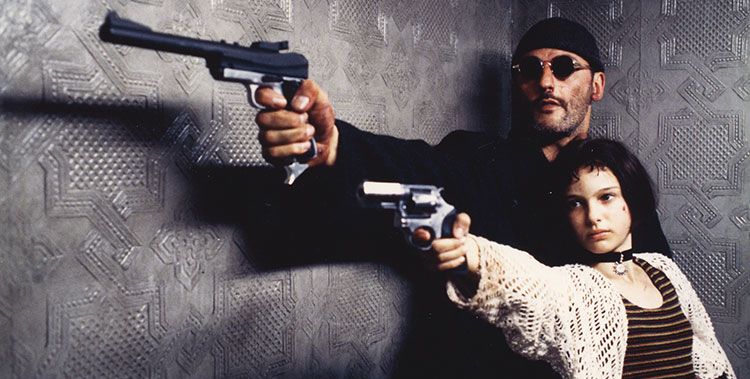
One can look to Japan for other provocative examples, both live-action and animated. The origins go back well before that, however, to the sixties and the pinky violence genre, which combine sex and…well, violence. While not all such “bad girl” films necessarily involve teenagers, some would certainly qualify, such as the marvellously-titled Terrifying Girls’ High School: Lynch Law Classroom, which lobs horror elements into the mix. I hope to cover more from this genre in the coming year. But teenage terrors extend beyond this: others worth mentioning with characters who can kill you as easily as they’d go shopping include Azumi, The Machine Girl and Mutant Girls Squad. These all represent an interesting counterpoint to the rigid role models typically imposed on women in Japanese society, and their popularity may represent a rebellion of sorts against this.
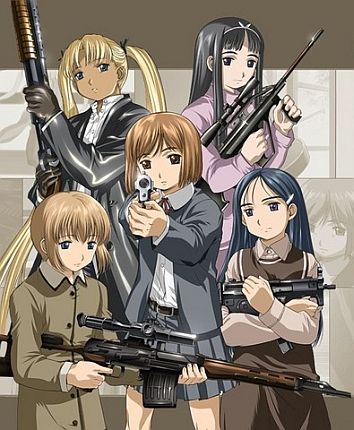 In a somewhat more light-hearted vein (for the most part), many anime and manga series have had teenage protagonists – as you’d expect, given they are often the core audience. The archetype goes back at least to the mid-1950’s, and Osama Tezuka’s Princess Knight, about a princess who must pretend to be male, so she can inherit the throne. There are too many of these even to list here, but some of the most well-known action-oriented examples in the West include Project A-ko, Sailor Moon, Blood: The Last Vampire, Cutie Honey, Gunslinger Girl (left), Noir and Dirty Pair – particularly Dirty Pair Flash, where both Kei and Yuri are seventeen-year olds.
In a somewhat more light-hearted vein (for the most part), many anime and manga series have had teenage protagonists – as you’d expect, given they are often the core audience. The archetype goes back at least to the mid-1950’s, and Osama Tezuka’s Princess Knight, about a princess who must pretend to be male, so she can inherit the throne. There are too many of these even to list here, but some of the most well-known action-oriented examples in the West include Project A-ko, Sailor Moon, Blood: The Last Vampire, Cutie Honey, Gunslinger Girl (left), Noir and Dirty Pair – particularly Dirty Pair Flash, where both Kei and Yuri are seventeen-year olds.
Probably the most notorious example of live-action is Battle Royale, which follows a class of 15-year olds as they are kidnapped by the goverment, put on a deserted island and ordered to kill each other, in order to strike fear into the rest of the nation’s youths. The results show that lethal intent is by no means limited to the male sex, and the film was condemned at the time of its release in late 2000, by some in the Japanese parliament as “crude and tasteless”, who also complained about the ‘R15’ rating, saying it was liable to harm teenagers. Rumour has it that it has been “banned” in the United States, but it’s more that the makers were concerned about possible US lawsuits, post-Columbine. The movie may eventually come out – in its 10th-anniversary, 3D version!- this year.
The movie is unquestionably an influence on The Hunger Games, a young-adult novel written by Suzanne Collins, now in the process of being made into a major film. In both the setting is sometime in the future, when the threat of chaos has forced the totalitarian government into tough measures: randomly selecting children to participate in a “kill or be killed” contest, televised nationally “pour discourager les autres”, as Voltaire almost once said. Collins has never acknowledged the similarities, and it’s possible she was unaware of underground cinema – but it’s hard to believe everyone who saw the manuscript was similarly ignorant.
My major concern is whether the film will be able to pack the wallop contained in some of the book’s sequences, while working within the PG-13 rating it’s aiming for. [I note the irony of the rating system: there’s nothing to stop teenagers from buying the books which describe, in bloody details, murder of and by children. But see those same fictional events acted out in a cinema? Not without an accompanying parent or guardian] One suspects the result will, inevitably, be watered-down: it will take some skill from director Gary Ross, to replace the visceral impact with a more emotional one. It’s certainly not the Twilight saga, which has sharply divided readers. Bella is too ’emo’ for many tastes, but the supporting characters provide some counterpoints to that argument. If you’re looking for strong female roles in that genre, forum contributor Yâoguài provided a useful introduction to some other entries worth a look.
 Quick: name a film where Saoirse Ronan plays a teenage assassin – besides Hanna. She seems to have developed a taste for the genre, as she also plays one in Violet & Daisy, directed by Geoffrey Fletcher (the screenwriter for Oscar-winner Precious). She is Daisy, along with Alexis Bledel as Violet: the two young killers for hire accept what they think will be a quick-and-easy job, until an unexpected target throws them off their plan. Said Ronan, “They couldn’t be more different [from Hanna]. Daisy is a really, really sweet girl. She’s not a natural killer like Violet is… They have their own little world. And everything is poppy and fun and about puppy dogs and dresses. They’re taking on this job because they want to get this dress that their pop idol has. Her name is Barbie Sunday.”
Quick: name a film where Saoirse Ronan plays a teenage assassin – besides Hanna. She seems to have developed a taste for the genre, as she also plays one in Violet & Daisy, directed by Geoffrey Fletcher (the screenwriter for Oscar-winner Precious). She is Daisy, along with Alexis Bledel as Violet: the two young killers for hire accept what they think will be a quick-and-easy job, until an unexpected target throws them off their plan. Said Ronan, “They couldn’t be more different [from Hanna]. Daisy is a really, really sweet girl. She’s not a natural killer like Violet is… They have their own little world. And everything is poppy and fun and about puppy dogs and dresses. They’re taking on this job because they want to get this dress that their pop idol has. Her name is Barbie Sunday.”
On television, one show stands out above all others: Buffy the Vampire Slayer, which followed the life of Buffy Summers, through the discovery of her powers and on through college and into adulthood. But the first three seasons of the series (as well as the feature which preceded it) all took place at High School, and it’s there that the show’s foundations were laid – and some would argue, its best work done (certainly, the show received its best ratings). The influence of Buffy on the field has been enormous, with a slew of shows which owe a debt to her in one form or another, and it’s no exaggeration to say that the heroine became a cultural icon. Indeed, it found a success, both critical and commercial, which those involved have found somewhat hard to recapture. Joss Whedon’s subsequent forays into TV, in Dollhouse and Firefly, both were canceled due to low ratings, though the former has its own devoted cult following.
Even the most contentious of the above, however, were a mere blip compared to the – and there’s not really another word – shitstorm that greeted Kick-Ass last year, mostly for its tiny killing machine, Hit Girl (Chloe Moretz). The relationship is similar to that in Leon, except that it’s her father (Nicolas Cage) who is her tutor. And, while Matilda never actually kills anyone, Hit Girl does so with gleeful, foul-mouthed abandon. “Okay, you cunts – let’s see what you can do now,” she says, before taking apart an apartment full of drug-dealers and low-lives. When it comes to the action, she’s certainly a great deal more competent and confident than the hero.
But not everyone was impressed…
“Millions are being spent to persuade you that Kick-Ass is harmless, comic-book entertainment suitable for 15-year-olds. Don’t let them fool you… It deliberately sells a perniciously sexualised view of children and glorifies violence, especially knife and gun crime, in a way that makes it one of the most deeply cynical, shamelessly irresponsible films ever… The reason the movie is sick, as well as thick, is that it breaks one of the last cinematic taboos by making the most violent, foul-mouthed and sexually aggressive character, Hit-Girl, an 11-year-old.The movie’s writers want us to see Hit-Girl not only as cool, but also sexy, like an even younger version of the baby- faced Oriental assassin in Tarantino’s Kill Bill 1. Paedophiles are going to adore her. One of the film’s creepiest aspects is that she’s made to look as seductive as possible… She’s fetishised in precisely the same way as Angelina Jolie in the Lara Croft movies, and Halle Berry in Catwoman. As if that isn’t exploitative enough, she’s also shown in a classic schoolgirl pose, in a short plaid-skirt with her hair in bunches, but carrying a big gun. Kick-Ass is not the harmless fun it pretends to be. Yes, it’s lightweight and silly, but it’s also cynical, premeditated and mindbogglingly irresponsible. And in Hit-Girl, the film-makers have created one of the most disturbing icons and damaging role-models in the history of cinema.”
Even for the most reactionary critic on the most reactionary newspaper (The Daily Mail) in the UK, that’s harsh – and largely unjustified. There’s very little sexual about Hit Girl at all; the hero has absolutely no interest in her (being keener on a girl who thinks he’s gay!), and she’s almost entirely no-nonsense and practical. The only possible exception is the scene where she dresses in the schoolgirl uniform shown atop this piece to get into the villains’ headquarters, and that’s exploiting the vulnerability of the image than its sexuality. But guess which pic, of all the dozens possible from the movie, is used to illustrate the review on Tookey’s own website? Yep. The same. He’s happy to condemn, while simultaneously exploiting it for his own moral agenda.
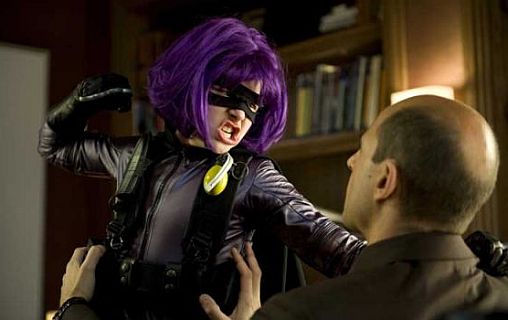 But his reading of the movie says a lot more about the writer than the film: as another critic mentioned, “If anyone finds her sexy. it’s because they find little kids sexy”. And the truth finally came out, as Tookey admitted (in the unrepentant review linked above) to having “experienced at first hand the attentions of three different men who would now be called paedophiles.” Three? As Oscar Wilde nearly put it, “To be molested once may be regarded as a misfortune; three times looks like carelessness.” It’s a known fact paedophiles were usually themselves abused as children, so I have absolutely no problem in calling Tookey out for expressing his tendencies in this area: put bluntly, I’d not leave my kids alone with him. And he was somehow surprised by the backlash?
But his reading of the movie says a lot more about the writer than the film: as another critic mentioned, “If anyone finds her sexy. it’s because they find little kids sexy”. And the truth finally came out, as Tookey admitted (in the unrepentant review linked above) to having “experienced at first hand the attentions of three different men who would now be called paedophiles.” Three? As Oscar Wilde nearly put it, “To be molested once may be regarded as a misfortune; three times looks like carelessness.” It’s a known fact paedophiles were usually themselves abused as children, so I have absolutely no problem in calling Tookey out for expressing his tendencies in this area: put bluntly, I’d not leave my kids alone with him. And he was somehow surprised by the backlash?
This is by no means an exhaustive survey. I could have gone on at quite some more length. Hanna. True Grit. Let the Right One In. But it does reflect, to some extent, the way society views teenage action heroines, because they are even more transgressive that adult action heroines. Women aren’t “supposed” to be assertive, self-confident or prepared to battle, physically, for what they believe. The same is true for children. Combine the two and – despite the examples drawn from history given above – you’ve got something which pushes a lot of society’s buttons. And I suspect that’s not something which is likely to change anytime soon.
See also:
- 13 Frightened Girls!
- Abigail (2019)
- The Accidental Keyhand, by Jen Swann Downey
- After the Pandemic
- Angelbound, by Christina Bauer
- The Archer
- Assassinaut
- Azumi
- Baby Assassins
- Barely Lethal
- Becky
- The Blind Spot, by Michael Robertson
- Blood +: Episodes 1-25
- Blood: The Last Vampire (animated)
- Blood: The Last Vampire (live-action)
- Bloodbath at Pinky High, Part 1
- Bloodbath at Pinky High, Part 2
- Bloody Chainsaw Girl
- Book of Monsters
- The Breadwinner
- Buffy the Vampire Slayer (film)
- Buffy the Vampire Slayer: season two
- Buffy the Vampire Slayer: season six
- Buffy the Vampire Slayer: season seven
- Cattle Annie and Little Britches
- Chastity Bites
- The Circle (Cirkeln)
- Cold November
- Counterfeiting in Suburbia
- Crimson, by Arthur Slade
- The Darkest Dawn
- Darkness on the Edge of Town
- Deidra and Laney Rob a Train
- The Dirty Pair
- E.M.P. 333 Days
- The Eagle Huntress
- Eko Eko Azarak
- Enola Holmes
- Enola Holmes 2
- Fair Game (1982)
- The Feral Sentence by G. C. Julien
- Final Girl
- Fugitive at 17
- Girl of Fire, by Norma Hinkens
- Go For Broke
- Grand Theft Auto Girls
- Grave Mercy, by Robin LaFevers
- Gunslinger Girl
- Hanna
- Hell’s Fury: Wanted Dead or Alive
- High School Girl Rika: Zombie Hunter
- High School Hellcats
- Homestead
- How I Live Now
- The Hunger Games (film)
- The Hunger Games: Catching Fire
- The Hunger Games: Mockingjay – Part 1
- The Hunger Games: Mockingjay – Part 2
- Hunter, Warrior, Commander by Andrew Maclure
- The incredible, true survival story of Juliane Koepcke
- Into the Dark, by J.A. Sutherland
- Joan of Arc: History vs. Cinema
- Justice High
- Kill Craft
- Kill La Kill
- Killer K
- Kim Possible
- Kite
- Kite (live action)
- Kitty the Killer
- Kyoko vs. Yuki
- The Last Dragonslayer
- The Last Survivors
- Lethal Dispatch, by Max Tomlinson
- Locked Up
- Maidentrip
- Miracles Still Happen
- Molly
- Mutant Girls Squad
- My Day
- Nausicaä of the Valley of the Wind
- Nightblade: A Book of Underrealm by Garrett Robinson
- No Safe Haven, by Kyla Stone
- The Poppy War, by R.F. Kuang
- De Prooi
- Prospect
- Resilience and the Lost Gems
- A Resistance
- Riddle Story of Devil
- Ride Hard: Live Free
- Rina Takeda: The Next Action Heroine?
- Riot Girls
- Run Hide Fight
- RWBY
- Sailor Suit and Machine Gun
- Sailor Suit and Machine Gun: Graduation
- Sexy Battle Girls
- Shadow Corps, by Justin Sloan
- Sket
- Sucker Punch
- Sugar & Spice
- The Sun At Midnight
- Switchblade Sisters
- Teenage Bank Heist
- Teenage Hooker Becomes a Killing Machine
- Tokyo Ballistic War
- The Tribe
- True Grit
- Vesper
- Violet and Daisy
- Viral
- War Witch
- Warchild: Pawn, by Ernie Lindsey
- Wendy Wu: Homecoming Warrior
- Wicked Blood
- Wilderness Survival for Girls
- Winter’s Bone
- The Witch Files
- The Witch: Part 1. The Subversion
- The Wrath of Becky
- Yasmine







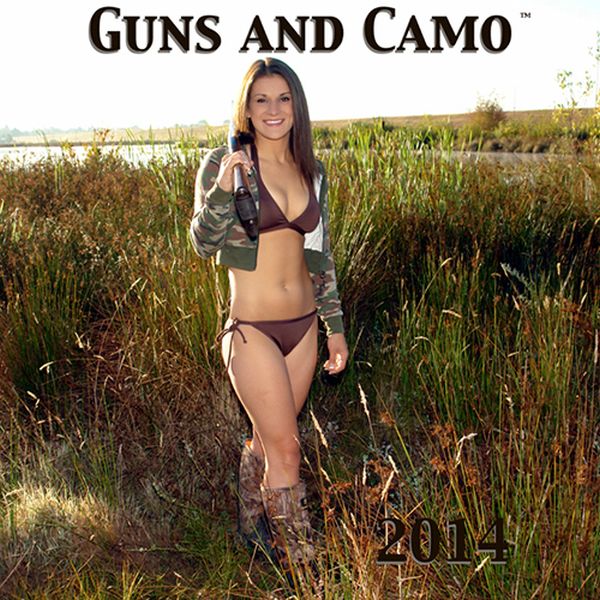



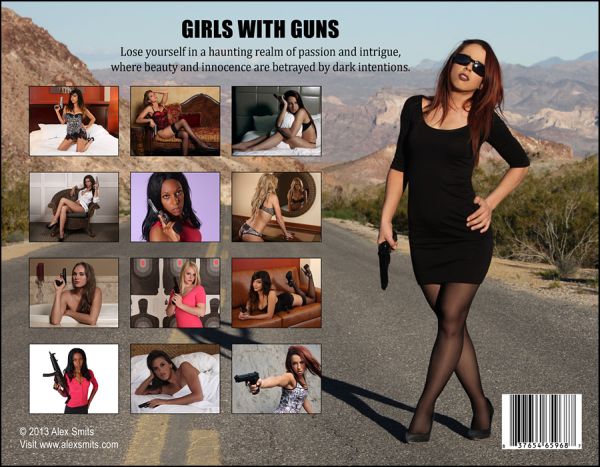





 We’ve covered a couple of entries in the series previously, but I’ve decided to start work a rather more comprehensive set of reviews, systematically watching them in order, rather than the sporadic pieces previously published, as they fell across my retinas. Some of those pieces were also reprints from a previous publication, and were also shorter than the ones I’ve grown accustomed to writing. This was largely inspired by stumbling across the first movie, dating from the seventies, and realizing that I could now cover the entire set. I hate incompleteness. :) This will be an ongoing project, likely taking me through the winter and into next spring, so check back often (okay: fairly often!) for updates.
We’ve covered a couple of entries in the series previously, but I’ve decided to start work a rather more comprehensive set of reviews, systematically watching them in order, rather than the sporadic pieces previously published, as they fell across my retinas. Some of those pieces were also reprints from a previous publication, and were also shorter than the ones I’ve grown accustomed to writing. This was largely inspired by stumbling across the first movie, dating from the seventies, and realizing that I could now cover the entire set. I hate incompleteness. :) This will be an ongoing project, likely taking me through the winter and into next spring, so check back often (okay: fairly often!) for updates. When the series started in 1974, it originally appeared to be trying to take on the Female Convict Scorpion series at its own game – both were inspired by Toru Shinohara manga series. However, going by the fact it took more than two decades for a second entry in the series, I can only presume the commercial returns weren’t anywhere near as strong. This starts off well, with policewoman Rei (Sugimoto) luring in, and then blowing away, the man responsible for torturing and killing another woman. Turns out the perpetrator was a diplomat and in the resulting scandal, Rie is sent to jail. Her chance at redemption comes when a gang of thugs stumble into the kidnapping of the daughter of a politician (Tamba): to avoid a scandal, Rie is offered a pardon if she infiltrates the kidnappers and kills them all. Initially, all goes to plan, with the first member taken out quickly, but it soon becomes clear the other members are rampaging psychos, and the situation rapidly spirals out of control, to the point where the politician yanks his support and orders the deaths of everyone, in the name of damage limitation – including both his daughter and Rie.
When the series started in 1974, it originally appeared to be trying to take on the Female Convict Scorpion series at its own game – both were inspired by Toru Shinohara manga series. However, going by the fact it took more than two decades for a second entry in the series, I can only presume the commercial returns weren’t anywhere near as strong. This starts off well, with policewoman Rei (Sugimoto) luring in, and then blowing away, the man responsible for torturing and killing another woman. Turns out the perpetrator was a diplomat and in the resulting scandal, Rie is sent to jail. Her chance at redemption comes when a gang of thugs stumble into the kidnapping of the daughter of a politician (Tamba): to avoid a scandal, Rie is offered a pardon if she infiltrates the kidnappers and kills them all. Initially, all goes to plan, with the first member taken out quickly, but it soon becomes clear the other members are rampaging psychos, and the situation rapidly spirals out of control, to the point where the politician yanks his support and orders the deaths of everyone, in the name of damage limitation – including both his daughter and Rie.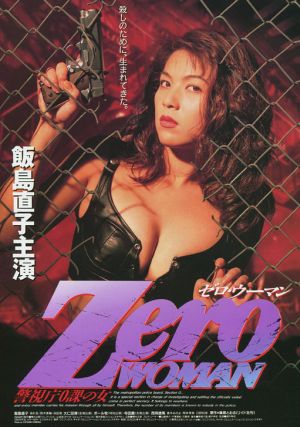 Probably the least accurate title of any film ever – at least Friday the 13th put out a few movies before using “final” – you definitely should begin here if you’re looking for much coherence. Rei (Iijima) is now partly employed as secretary to the head of Section Zero, but also takes out criminals for whom traditional channels of law enforcement aren’t enough, for one reason or another. She also pals around with Takako (Fukuoka), a detective from another section and a girl he helped bring out of delinquency, in what’s vaguely intimated as a love triangle. One night, they witness a hit and run, and discover the perpetrator (Suzuki) is the daughter of a powerful economic figure. Despite encountering official resistance, Rei and Takako persist with their investigation and, inevitably, this brings out more robust sanctions.
Probably the least accurate title of any film ever – at least Friday the 13th put out a few movies before using “final” – you definitely should begin here if you’re looking for much coherence. Rei (Iijima) is now partly employed as secretary to the head of Section Zero, but also takes out criminals for whom traditional channels of law enforcement aren’t enough, for one reason or another. She also pals around with Takako (Fukuoka), a detective from another section and a girl he helped bring out of delinquency, in what’s vaguely intimated as a love triangle. One night, they witness a hit and run, and discover the perpetrator (Suzuki) is the daughter of a powerful economic figure. Despite encountering official resistance, Rei and Takako persist with their investigation and, inevitably, this brings out more robust sanctions.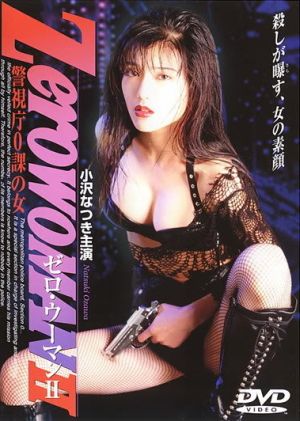 Confusingly titled in the West, without any indication it wasn’t the first of the rebooted franchise, this perhaps explains why there’s little or no explanation of… Well, anything, really. What is Section Zero? Who is Rei? Where did she come from? “Never mind about that,” seems to be the film’s attitude, “Here are Natsuki Ozawa’s breasts to distract you from such trifles.” That’s particularly the case early on, when it seems Rei is unable to go five minutes without showing them off, whether it’s through being molested, becoming inescapably randy or simply taking a soapy shower (to wash off the blood after a kill, so I guess it’s a shower necessary to the plot – it also replays the intruder shower scene from its predecessor, with a different ending).
Confusingly titled in the West, without any indication it wasn’t the first of the rebooted franchise, this perhaps explains why there’s little or no explanation of… Well, anything, really. What is Section Zero? Who is Rei? Where did she come from? “Never mind about that,” seems to be the film’s attitude, “Here are Natsuki Ozawa’s breasts to distract you from such trifles.” That’s particularly the case early on, when it seems Rei is unable to go five minutes without showing them off, whether it’s through being molested, becoming inescapably randy or simply taking a soapy shower (to wash off the blood after a kill, so I guess it’s a shower necessary to the plot – it also replays the intruder shower scene from its predecessor, with a different ending).

 After the genuinely impressive bleakness of Assassin Lovers, the series comes crashing back to earth with a splat like a rotten tomato for this entry, which fizzles out early on, and then manages to lumber on for another 45 minutes. Rei (Tachihara) spends her time between missions hanging out at a gay bar, and rescues one of the rent boys, Mitsusu (Kitagawa), who ply their trade there after a vicious assault – accompanied, it has to be said, by the least appropriate music in the history of cinematic homosexual rape. He ends up moving in with her, to the latest in a series of unfurnished apartments provided by Section Zero, and the two damaged individuals start creating a life, of sorts, for themselves. However, there’s a serial killer, apparently with a deep hatred of men, operating in the area, and Rei is given the mission of tracking down and eliminating the psycho.
After the genuinely impressive bleakness of Assassin Lovers, the series comes crashing back to earth with a splat like a rotten tomato for this entry, which fizzles out early on, and then manages to lumber on for another 45 minutes. Rei (Tachihara) spends her time between missions hanging out at a gay bar, and rescues one of the rent boys, Mitsusu (Kitagawa), who ply their trade there after a vicious assault – accompanied, it has to be said, by the least appropriate music in the history of cinematic homosexual rape. He ends up moving in with her, to the latest in a series of unfurnished apartments provided by Section Zero, and the two damaged individuals start creating a life, of sorts, for themselves. However, there’s a serial killer, apparently with a deep hatred of men, operating in the area, and Rei is given the mission of tracking down and eliminating the psycho.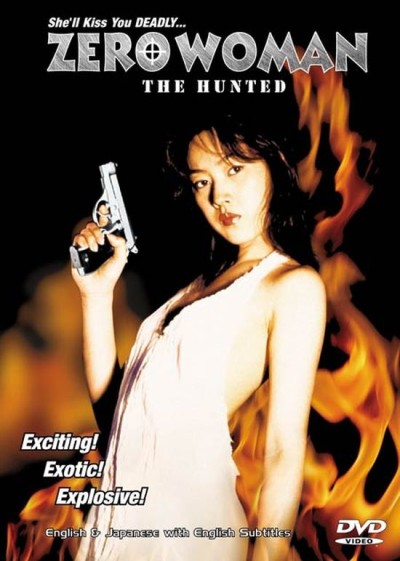 If ever I become an evil overlord, I will ensure my minions’ idea of security does not involve walking slowly in the open, towards an attacker, while firing wide of them from a range no greater than a slightly oversize dinner-table. That’s the first thing we take from this, which begins with a thoroughly implausible scene where Rei (Ono, who had been a part of 90’s J-pop group CoCo) manages to drown her target, a German industrialist, despite him being roughly twice her size, and without anyone in or around the swimming-pool noticing anything. She then climbs out, pulling a gun from who knows where, kills bodyguards who’d fail the Imperial Stormtrooper accuracy exam, and abseils down the side of the building to escape. That sets the tone for much of what follows, combining a reunion with someone from her past, a blossoming relationship with a chef, and her boss’s traditional surly reluctance to allow anything as banal as “personal happiness” to distract his #1 killer from her work.
If ever I become an evil overlord, I will ensure my minions’ idea of security does not involve walking slowly in the open, towards an attacker, while firing wide of them from a range no greater than a slightly oversize dinner-table. That’s the first thing we take from this, which begins with a thoroughly implausible scene where Rei (Ono, who had been a part of 90’s J-pop group CoCo) manages to drown her target, a German industrialist, despite him being roughly twice her size, and without anyone in or around the swimming-pool noticing anything. She then climbs out, pulling a gun from who knows where, kills bodyguards who’d fail the Imperial Stormtrooper accuracy exam, and abseils down the side of the building to escape. That sets the tone for much of what follows, combining a reunion with someone from her past, a blossoming relationship with a chef, and her boss’s traditional surly reluctance to allow anything as banal as “personal happiness” to distract his #1 killer from her work.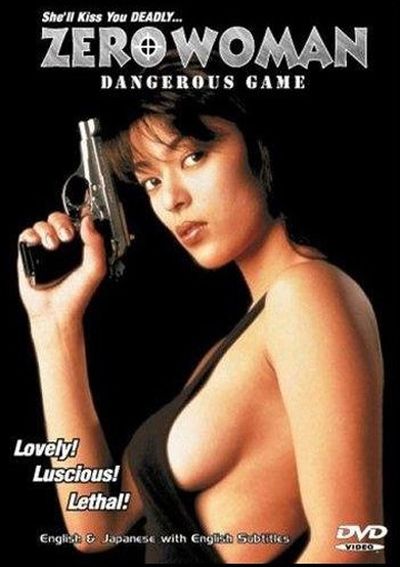 The main mission given to Rie (Shiratori this time) is a little bit different, from her usual, straight-forward assassinations. Instead, she’s given the job of protecting a witness. Nana (Matsuda), the disgruntled mistress of an organ-trafficking ring, who has had enough and agreed to co-operate with the police. Rie is part of the protection detail, but soon finds out that the gangsters, under ever-so strange boss Kaneda (Nogami) with his transvestite tendencies, are not going to sit back and wait for Nana to take the witness stand. Oddly, the cops let Nana stay in her own apartment, perhaps figuring that’s the last place her former lover would look. but when that is unsurprisingly stormed, Rie takes the target back to the operative’s flat, where they hang out, exchanging small talk – that’s mostly Nana, of course, since Rie is about as talkative as the enormous pet fish she has in a tank, and to which she feeds goldfish.
The main mission given to Rie (Shiratori this time) is a little bit different, from her usual, straight-forward assassinations. Instead, she’s given the job of protecting a witness. Nana (Matsuda), the disgruntled mistress of an organ-trafficking ring, who has had enough and agreed to co-operate with the police. Rie is part of the protection detail, but soon finds out that the gangsters, under ever-so strange boss Kaneda (Nogami) with his transvestite tendencies, are not going to sit back and wait for Nana to take the witness stand. Oddly, the cops let Nana stay in her own apartment, perhaps figuring that’s the last place her former lover would look. but when that is unsurprisingly stormed, Rie takes the target back to the operative’s flat, where they hang out, exchanging small talk – that’s mostly Nana, of course, since Rie is about as talkative as the enormous pet fish she has in a tank, and to which she feeds goldfish.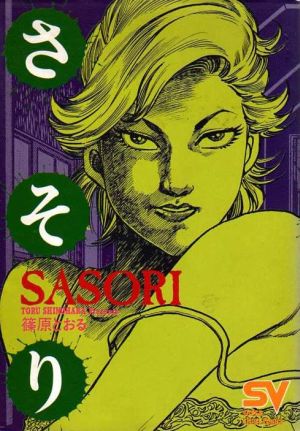 In the first half of the 1970’s, Meiko Kaji was to the slightly-disreputable end of Japanese cinema, much what Pam Grier was to the same end of Hollywood movies. Both made a career out of playing strong female characters, often operating on or beyond the boundaries of the law, and with no compunction about using violence to achieve their ends – which often involved taking revenge on those (almost alwayx men) who had wronged them. The Sasori [Japanese for “scorpion”] was not Kaji’s first foray into the genre, having cut her teeth on the Noraneko Rokku [Straycat or Alleycat Rock] films, a couple of years previously.
In the first half of the 1970’s, Meiko Kaji was to the slightly-disreputable end of Japanese cinema, much what Pam Grier was to the same end of Hollywood movies. Both made a career out of playing strong female characters, often operating on or beyond the boundaries of the law, and with no compunction about using violence to achieve their ends – which often involved taking revenge on those (almost alwayx men) who had wronged them. The Sasori [Japanese for “scorpion”] was not Kaji’s first foray into the genre, having cut her teeth on the Noraneko Rokku [Straycat or Alleycat Rock] films, a couple of years previously.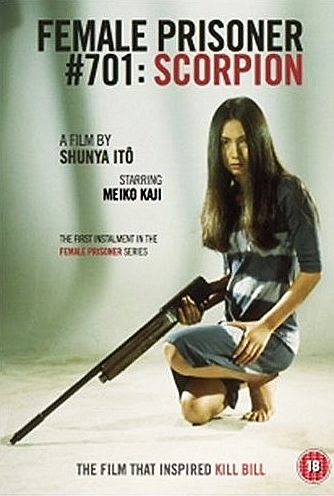
 Right from the start, Nami (Kaji) established her utterly hardcore credentials, as she’s trying to dig her way out of the dungeon where she has been for the past year. With a spoon. Held in her teeth. She’s let out for the day because a bigwig is visiting, but takes the opportunity to attack warden Goda (Watanabe), almost depriving him of the sight of his other eye. As punishment for the resulting riot, Goda sends four guards to gang-rape Nami, and all the inmates are sent to a hard-labour camp. On the way back, they beat Nami as punishment, leaving her near-dead but it turns out that was just her ruse to get the guards to open the back of the van and escape. She leads the women across a blasted landscape, revenge once more on her mind, with Goda’s men in hot pursuit.
Right from the start, Nami (Kaji) established her utterly hardcore credentials, as she’s trying to dig her way out of the dungeon where she has been for the past year. With a spoon. Held in her teeth. She’s let out for the day because a bigwig is visiting, but takes the opportunity to attack warden Goda (Watanabe), almost depriving him of the sight of his other eye. As punishment for the resulting riot, Goda sends four guards to gang-rape Nami, and all the inmates are sent to a hard-labour camp. On the way back, they beat Nami as punishment, leaving her near-dead but it turns out that was just her ruse to get the guards to open the back of the van and escape. She leads the women across a blasted landscape, revenge once more on her mind, with Goda’s men in hot pursuit.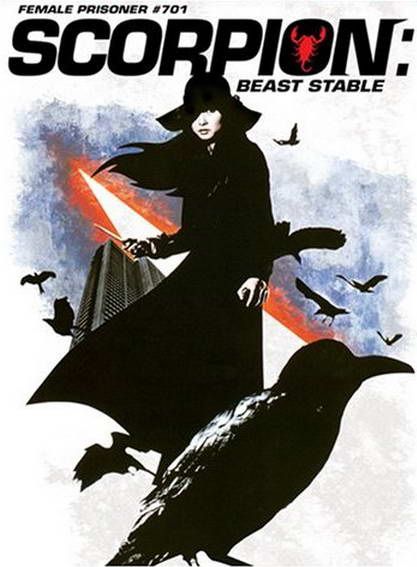 When this begins, Nami (Kaji) is on the run, and slices the arm off Detective Kondo (Narita) after he handcuffs himself to her. She befriends street hooker Yuki (Watanabe), who runs foul of the locak Yakuza gang by turning tricks on their turn, while trying to care for her brain-damaged brother, whom she also services sexually, to stop him from raping women(!). After Nami is involved in the death of a gang member who was blackmailing her, the gang’s madam Katsu (Lee), who knew the Scorpion from her own prison days, captures her, locking our heroine up in a literal big bird-cage. But after the true horror of the Yakuza’s treatment of their women is revealed (it starts with a golf-club going where no golf-club should ever go), Nami escapes and carves a bloody path of revenge on those responsible. When Katsu realizes what’s going on, she turns herself in to the police, figuring jail will be safe from Sasori’s wrath. Take a wild stab in the dark… Which, by coincidence is exactly what Katsu deserves.
When this begins, Nami (Kaji) is on the run, and slices the arm off Detective Kondo (Narita) after he handcuffs himself to her. She befriends street hooker Yuki (Watanabe), who runs foul of the locak Yakuza gang by turning tricks on their turn, while trying to care for her brain-damaged brother, whom she also services sexually, to stop him from raping women(!). After Nami is involved in the death of a gang member who was blackmailing her, the gang’s madam Katsu (Lee), who knew the Scorpion from her own prison days, captures her, locking our heroine up in a literal big bird-cage. But after the true horror of the Yakuza’s treatment of their women is revealed (it starts with a golf-club going where no golf-club should ever go), Nami escapes and carves a bloody path of revenge on those responsible. When Katsu realizes what’s going on, she turns herself in to the police, figuring jail will be safe from Sasori’s wrath. Take a wild stab in the dark… Which, by coincidence is exactly what Katsu deserves. Nami (Kaji) is about to get married, but her wedding day is rudely interrupted by the arrival of the cops, who arrest her. On the way to prison (and, unsurprisingly, death row, given the body count left behind in the previous three movies), she takes out the driver, causing a crash. The injured Scorpion staggers away, and is rescued by Kudo (Tamura), a former political radical who was brutalized by the police for his actions, and so has a massive load of resentment against them. After being informed of Kudo’s harbouring of Nami by a worked at the sex-club where he works, the cops take him in: and use both physical and psychological torture to try and make him give up her location. Eventually arrested, Nami is sentenced to death, but the cops intend to make sure the time leading up to her execution is as unpleasant and possible, and the detective in charge, Hirose (Tsukata), is intent on making even Nami’s death as lonely an experience as possible.
Nami (Kaji) is about to get married, but her wedding day is rudely interrupted by the arrival of the cops, who arrest her. On the way to prison (and, unsurprisingly, death row, given the body count left behind in the previous three movies), she takes out the driver, causing a crash. The injured Scorpion staggers away, and is rescued by Kudo (Tamura), a former political radical who was brutalized by the police for his actions, and so has a massive load of resentment against them. After being informed of Kudo’s harbouring of Nami by a worked at the sex-club where he works, the cops take him in: and use both physical and psychological torture to try and make him give up her location. Eventually arrested, Nami is sentenced to death, but the cops intend to make sure the time leading up to her execution is as unpleasant and possible, and the detective in charge, Hirose (Tsukata), is intent on making even Nami’s death as lonely an experience as possible.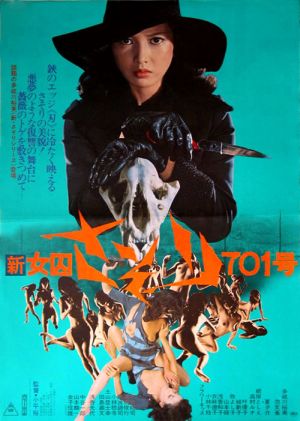 Just goes to show that the “cinematic reboot” is not a 21st-century invention, e.g. Batman or James Bond. For a mere three years after Meiko Kaji showed her sting as Nami, the studio reset the series, giving it a new director, new (and much more talkative) lead actress, and returning Nami Matsushima to a happy, criminal record-free young women, with a loving boyfriend. Except, of course, he turns out not to love her quite as much. Things start to collapse after her sister uncovers evidence of major government corruption, and passes it to Nami, shortly before being kidnapped. After Nami uncovers the truth – her sister is killed and she is framed for the murder, with the help of her boyfriend, and sentenced to 15 years in prison. Initially an easy mark for the tough girls in her cell, Nami soon develops her mean streak. And she’s going to need it, because the politician behind it all is looking to tidy up the loose end she represents, by killing her and making the death look like a suicide. Name turns the tables, in incendiary fashion, and it’s clear that she’s one loose end that won’t be quietly disposed of.
Just goes to show that the “cinematic reboot” is not a 21st-century invention, e.g. Batman or James Bond. For a mere three years after Meiko Kaji showed her sting as Nami, the studio reset the series, giving it a new director, new (and much more talkative) lead actress, and returning Nami Matsushima to a happy, criminal record-free young women, with a loving boyfriend. Except, of course, he turns out not to love her quite as much. Things start to collapse after her sister uncovers evidence of major government corruption, and passes it to Nami, shortly before being kidnapped. After Nami uncovers the truth – her sister is killed and she is framed for the murder, with the help of her boyfriend, and sentenced to 15 years in prison. Initially an easy mark for the tough girls in her cell, Nami soon develops her mean streak. And she’s going to need it, because the politician behind it all is looking to tidy up the loose end she represents, by killing her and making the death look like a suicide. Name turns the tables, in incendiary fashion, and it’s clear that she’s one loose end that won’t be quietly disposed of.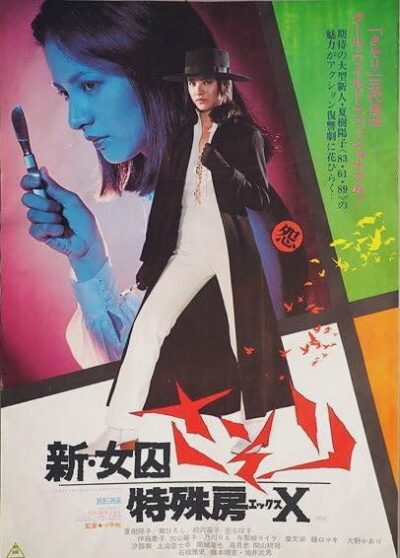 The comparisons of Takigawa to Lazenby above proved appropriate in another way, both being canned after one entry playing the iconic title character, which is probably just as symptomatic of something. The replacement here as Nami Matsushima is Natsuki, who seems to go back toward a more taciturn heroine, closer to the original. But it’s, effectively, another reboot, with not even a nod to the previous entry. In this case, the heroine is a nurse, framed for her involvement in the hospital murder of a politician who was threatening to expose corrupt practices.
The comparisons of Takigawa to Lazenby above proved appropriate in another way, both being canned after one entry playing the iconic title character, which is probably just as symptomatic of something. The replacement here as Nami Matsushima is Natsuki, who seems to go back toward a more taciturn heroine, closer to the original. But it’s, effectively, another reboot, with not even a nod to the previous entry. In this case, the heroine is a nurse, framed for her involvement in the hospital murder of a politician who was threatening to expose corrupt practices.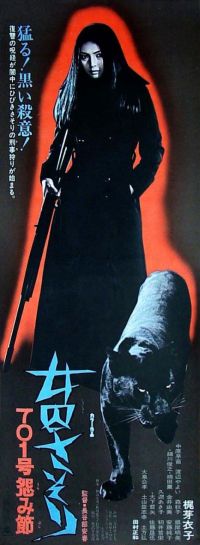

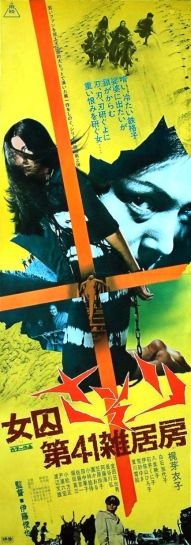

 “Z is for Zeiram”
“Z is for Zeiram”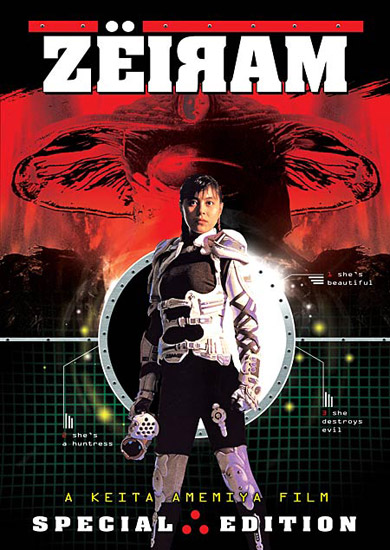 Zeiram and its sequel, Zeiram 2, both concern a creature which combines all the most unpleasant and lethal features of The Thing with The Terminator. It’s humanoid, at least in the number of functioning limbs, but its head appears almost mushroom shaped – though it’s hard to tell where Zeiram ends and its hat begins, for there’s a second face, embedded in the hat. This is capable of extending on a tentacle, to attack victims, taking in nourishment, and there’s evidence to suggest that it can absorb their DNA and use it to create monsters. Oh, and the rest of it is almost impossible to destroy.
Zeiram and its sequel, Zeiram 2, both concern a creature which combines all the most unpleasant and lethal features of The Thing with The Terminator. It’s humanoid, at least in the number of functioning limbs, but its head appears almost mushroom shaped – though it’s hard to tell where Zeiram ends and its hat begins, for there’s a second face, embedded in the hat. This is capable of extending on a tentacle, to attack victims, taking in nourishment, and there’s evidence to suggest that it can absorb their DNA and use it to create monsters. Oh, and the rest of it is almost impossible to destroy.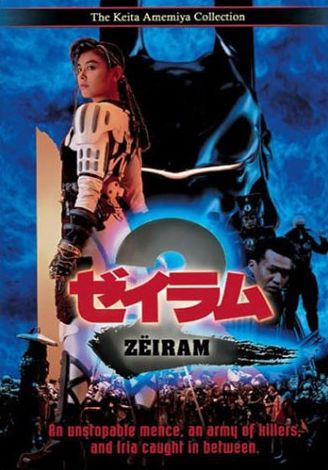 The sequel, which came out three years later, restores the “i” in the title, which was inexplicably removed from the original for it US release by Fox Lorber. This installment starts off as if it’s going to go in some radically different directions, even if all the main players are back. Iria is seeking an ancient artifact called the Carmarite, and additionally, has a new assistant, but he turns out to be untrustworthy. Meanwhile, a shadowy group has succeeded in regenerating Zeiram as a cyborg warrior (which makes a lot more sense if you’ve seen the anime, and know its origins), bending its will to their needs and turning it into a weapon. While initially successfully, this works about as well as most plans usually do, and it’s not longer before Zeiram is much more a menace than an ally.
The sequel, which came out three years later, restores the “i” in the title, which was inexplicably removed from the original for it US release by Fox Lorber. This installment starts off as if it’s going to go in some radically different directions, even if all the main players are back. Iria is seeking an ancient artifact called the Carmarite, and additionally, has a new assistant, but he turns out to be untrustworthy. Meanwhile, a shadowy group has succeeded in regenerating Zeiram as a cyborg warrior (which makes a lot more sense if you’ve seen the anime, and know its origins), bending its will to their needs and turning it into a weapon. While initially successfully, this works about as well as most plans usually do, and it’s not longer before Zeiram is much more a menace than an ally.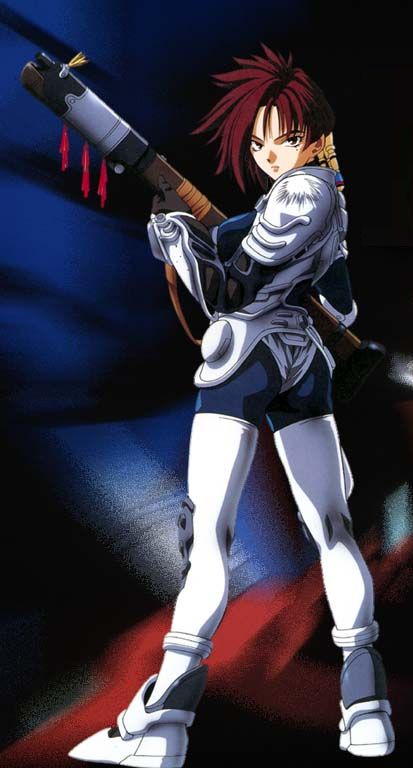 Though released several years later, this is a prequel to the two Zeiram movies, telling the story of the first encounter between Iria (Hisakawa, who was also Sailor Mercury) and Zeiram. At the time, she was an apprentice bounty-hunter, working alongside her brother Gren. They take a mission to rescue a VIP and recover the cargo from a stranded space-ship. However, once there, they discover the “cargo” is actually the alien Zeiram, which a corporation is interested in using as a weapon. The result leaves her brother apparently dead, and Iria now the target for the corporation, who want to hush up their thoroughly-dubious plan, by any means necessary. Fortunately, as well as her own skills, our heroine has the assistance of former rival bounty-hunter, Fujikuro (Chiva), endearing urchin Kei (Kanai), and Bob (Ikeda), a colleague whose consciousness has been turned into an AI.
Though released several years later, this is a prequel to the two Zeiram movies, telling the story of the first encounter between Iria (Hisakawa, who was also Sailor Mercury) and Zeiram. At the time, she was an apprentice bounty-hunter, working alongside her brother Gren. They take a mission to rescue a VIP and recover the cargo from a stranded space-ship. However, once there, they discover the “cargo” is actually the alien Zeiram, which a corporation is interested in using as a weapon. The result leaves her brother apparently dead, and Iria now the target for the corporation, who want to hush up their thoroughly-dubious plan, by any means necessary. Fortunately, as well as her own skills, our heroine has the assistance of former rival bounty-hunter, Fujikuro (Chiva), endearing urchin Kei (Kanai), and Bob (Ikeda), a colleague whose consciousness has been turned into an AI.
 Joan of Arc
Joan of Arc Such tactics were necessary in Western society because of the increasing belief that women were not “fit” for combat. It was still possible as late as 1915, when Dorothy Lawrence (right) posed as a man to reach the Somme front-lines, where she laid mines, until illness forced her to reveal her identity. Her memoirs are available, free,
Such tactics were necessary in Western society because of the increasing belief that women were not “fit” for combat. It was still possible as late as 1915, when Dorothy Lawrence (right) posed as a man to reach the Somme front-lines, where she laid mines, until illness forced her to reveal her identity. Her memoirs are available, free, 
 In a somewhat more light-hearted vein (for the most part), many anime and manga series have had teenage protagonists – as you’d expect, given they are often the core audience. The archetype goes back at least to the mid-1950’s, and Osama Tezuka’s Princess Knight, about a princess who must pretend to be male, so she can inherit the throne. There are too many of these even to list here, but some of the most well-known action-oriented examples in the West include Project A-ko, Sailor Moon, Blood: The Last Vampire, Cutie Honey, Gunslinger Girl (left), Noir and Dirty Pair – particularly Dirty Pair Flash, where both Kei and Yuri are seventeen-year olds.
In a somewhat more light-hearted vein (for the most part), many anime and manga series have had teenage protagonists – as you’d expect, given they are often the core audience. The archetype goes back at least to the mid-1950’s, and Osama Tezuka’s Princess Knight, about a princess who must pretend to be male, so she can inherit the throne. There are too many of these even to list here, but some of the most well-known action-oriented examples in the West include Project A-ko, Sailor Moon, Blood: The Last Vampire, Cutie Honey, Gunslinger Girl (left), Noir and Dirty Pair – particularly Dirty Pair Flash, where both Kei and Yuri are seventeen-year olds. Quick: name a film where Saoirse Ronan plays a teenage assassin – besides Hanna. She seems to have developed a taste for the genre, as she also plays one in Violet & Daisy, directed by Geoffrey Fletcher (the screenwriter for Oscar-winner Precious). She is Daisy, along with Alexis Bledel as Violet: the two young killers for hire accept what they think will be a quick-and-easy job, until an unexpected target throws them off their plan.
Quick: name a film where Saoirse Ronan plays a teenage assassin – besides Hanna. She seems to have developed a taste for the genre, as she also plays one in Violet & Daisy, directed by Geoffrey Fletcher (the screenwriter for Oscar-winner Precious). She is Daisy, along with Alexis Bledel as Violet: the two young killers for hire accept what they think will be a quick-and-easy job, until an unexpected target throws them off their plan.  But his reading of the movie says a lot more about the writer than the film: as another critic
But his reading of the movie says a lot more about the writer than the film: as another critic 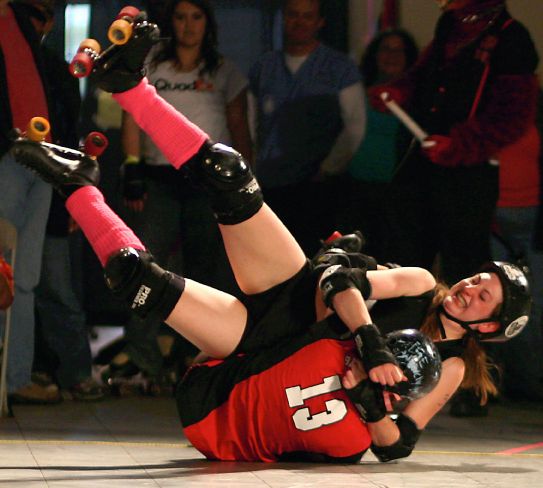 We used to be fairly well into roller derby, and reports of these bouts have previously graced the pages of this site. Our involvement in the scene came to a sudden halt a couple of years back when a shift-change at work left me holding down the fort on Friday and Saturday evenings, which are basically the prime nights for bouts. While the shift has its advantages, it does mean the only bout we’ve seen in about the past five years was one at the Arizona State Fair which happened to coincide with a midweek night off. I still possess my AZRD shirt, which I wear it to work occasionally, and have followed (vaguely) the schisms and ructions as groups have split, flourished and folded locally. Phoenix alone, as well as AZRD, has the Arizona Derby Dames, Arizona Roller Girls, Harmonic Violence Rollergirls, Renegade Roller Girls and Desert Dolls Roller Derby (somewhat) active, more than any other city in the world. I’m unsure whether this splintering is a good thing.
We used to be fairly well into roller derby, and reports of these bouts have previously graced the pages of this site. Our involvement in the scene came to a sudden halt a couple of years back when a shift-change at work left me holding down the fort on Friday and Saturday evenings, which are basically the prime nights for bouts. While the shift has its advantages, it does mean the only bout we’ve seen in about the past five years was one at the Arizona State Fair which happened to coincide with a midweek night off. I still possess my AZRD shirt, which I wear it to work occasionally, and have followed (vaguely) the schisms and ructions as groups have split, flourished and folded locally. Phoenix alone, as well as AZRD, has the Arizona Derby Dames, Arizona Roller Girls, Harmonic Violence Rollergirls, Renegade Roller Girls and Desert Dolls Roller Derby (somewhat) active, more than any other city in the world. I’m unsure whether this splintering is a good thing.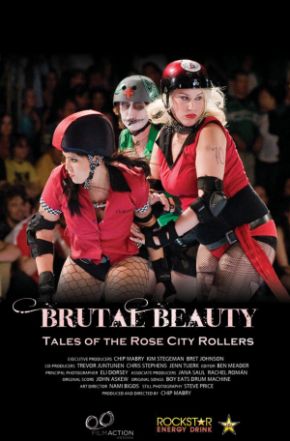 For the next entry, we leap forward to 2009, and Portland – a city which all we know about, we learned from Portlandia. And, on that basis, of course it’s a city which has roller derby, where it sprung, virtually fully-fledged to four-figure crowds. This is less of a landmark doc, in that it doesn’t cover the beginning, middle or end. It’s basically a year or so in the lives of the participants in the Rose City Rollers, which is the Portland league. It covers both their local season, and then, once that’s over, follows the travelling team, the Wheels of Justice, first as they head down to San Francisco to take on their hated rivals, then over to Denver for the regional championships.
For the next entry, we leap forward to 2009, and Portland – a city which all we know about, we learned from Portlandia. And, on that basis, of course it’s a city which has roller derby, where it sprung, virtually fully-fledged to four-figure crowds. This is less of a landmark doc, in that it doesn’t cover the beginning, middle or end. It’s basically a year or so in the lives of the participants in the Rose City Rollers, which is the Portland league. It covers both their local season, and then, once that’s over, follows the travelling team, the Wheels of Justice, first as they head down to San Francisco to take on their hated rivals, then over to Denver for the regional championships.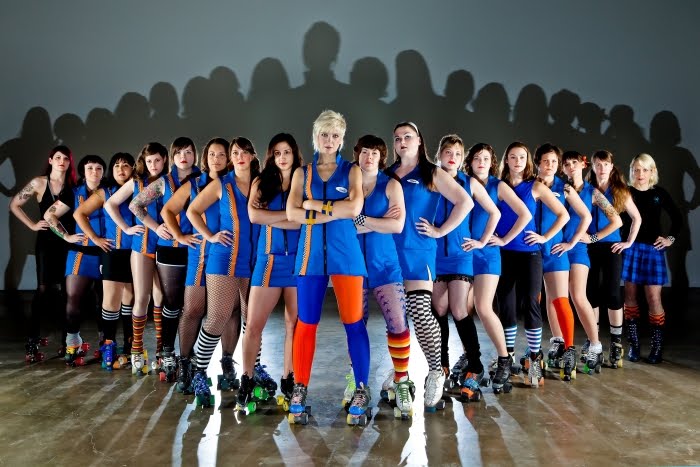 Not that there is any shortage of said personalities, such as the mother and daughter who both take part in the sport, or the three sisters who have been roller-skating virtually their entire life, and are feared across the entire Seattle league. There are, admittedly stories about romance and marriage included, but even these have a close connection to roller-derby, like the guy who proposes after his girlfriend became part of the championship-winning team [I can relate to this, having proposed to my wife immediately after the Arizona Diamondbacks won the 2001 World Series!]. I also enjoyed the insight into the different teams, like the Sockit Wenches (right) or the Derby Liberation Front, and the different ways in which they both perceive themselves and are perceived from the outside. Each has a different group personality, which of course, attracts other like-minded individuals, reinforcing that aspect of the team.
Not that there is any shortage of said personalities, such as the mother and daughter who both take part in the sport, or the three sisters who have been roller-skating virtually their entire life, and are feared across the entire Seattle league. There are, admittedly stories about romance and marriage included, but even these have a close connection to roller-derby, like the guy who proposes after his girlfriend became part of the championship-winning team [I can relate to this, having proposed to my wife immediately after the Arizona Diamondbacks won the 2001 World Series!]. I also enjoyed the insight into the different teams, like the Sockit Wenches (right) or the Derby Liberation Front, and the different ways in which they both perceive themselves and are perceived from the outside. Each has a different group personality, which of course, attracts other like-minded individuals, reinforcing that aspect of the team. Last month, we saw MMA star Gina Carano hit the big-screen in Haywire, but she’s not the first genuine female martial-artist to have started a movie career. Most obviously, Cynthia Rothtock was a five-time World Karate Champion in forms and weapons, and has a number of black belts in various disciplines. Similarly, Jeeja Yanin was a third-Dan black belt in Taekwondo, before hitting the silver screen in Chocolat. But here, we’ll be looking at the name that has recently emerged out of Japan, Rina Takeda, holder of a black belt in Ryukyu Shorin-ryu Karate.
Last month, we saw MMA star Gina Carano hit the big-screen in Haywire, but she’s not the first genuine female martial-artist to have started a movie career. Most obviously, Cynthia Rothtock was a five-time World Karate Champion in forms and weapons, and has a number of black belts in various disciplines. Similarly, Jeeja Yanin was a third-Dan black belt in Taekwondo, before hitting the silver screen in Chocolat. But here, we’ll be looking at the name that has recently emerged out of Japan, Rina Takeda, holder of a black belt in Ryukyu Shorin-ryu Karate.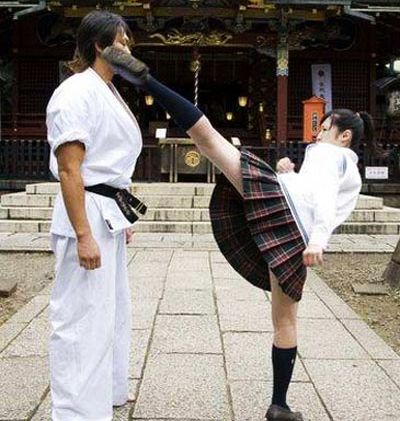 The entertainment value you get from this may depend on your expectations. It undoubtedly works best as a party-tape, show-casing the “no wires, CGI or stunt doubles” approach, but I have to beg to differ with some of the critical savaging it has received. Even
The entertainment value you get from this may depend on your expectations. It undoubtedly works best as a party-tape, show-casing the “no wires, CGI or stunt doubles” approach, but I have to beg to differ with some of the critical savaging it has received. Even  The film manages to cram just about every cliché of martial-arts films into its 92 minutes, with a plot driven by four major threads:
The film manages to cram just about every cliché of martial-arts films into its 92 minutes, with a plot driven by four major threads: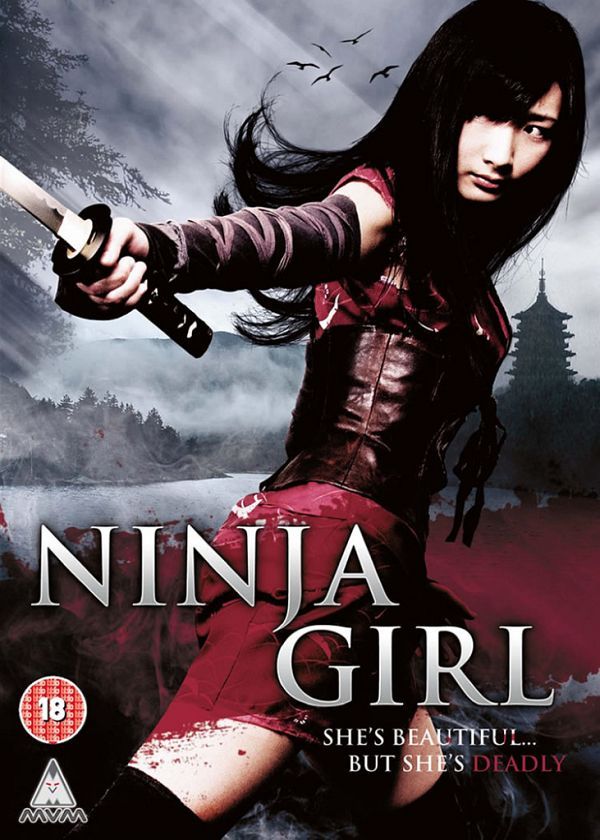 From the director of Alien vs. Ninja, the story here centres on a pair of ninjas, Shimotsuki and Hyotsuki, who are carrying on what appears to be a family tradition, kidnapping women from other clans’ villages, and taking them back to their own for nefarious purposes – let’s just say, the phrase “tools of pleasure” crops up on more than one occasion. They ar returning with their latest batch of four, including Kisaragi (Takeda), who is a ninja in her own right. With the help of a mysterious man (Sato), Kisuragi and her colleagues in imprisonment are released from their bondage – but that is only the first obstacle between them and their freedom. Of course, it turns out the heroine is not quite as innocent as she appears, and has an agenda of her own, because her mother was kidnapped by the same sleazy ninjas, when Kisuragi was just a baby.
From the director of Alien vs. Ninja, the story here centres on a pair of ninjas, Shimotsuki and Hyotsuki, who are carrying on what appears to be a family tradition, kidnapping women from other clans’ villages, and taking them back to their own for nefarious purposes – let’s just say, the phrase “tools of pleasure” crops up on more than one occasion. They ar returning with their latest batch of four, including Kisaragi (Takeda), who is a ninja in her own right. With the help of a mysterious man (Sato), Kisuragi and her colleagues in imprisonment are released from their bondage – but that is only the first obstacle between them and their freedom. Of course, it turns out the heroine is not quite as innocent as she appears, and has an agenda of her own, because her mother was kidnapped by the same sleazy ninjas, when Kisuragi was just a baby.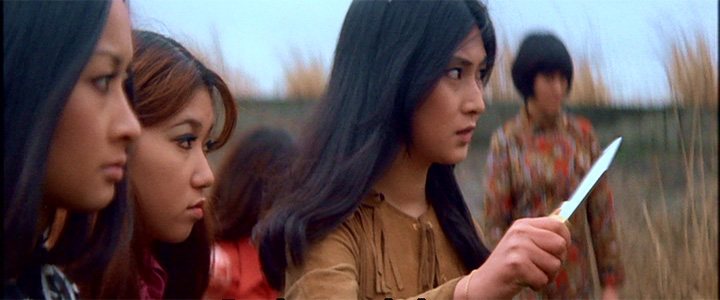
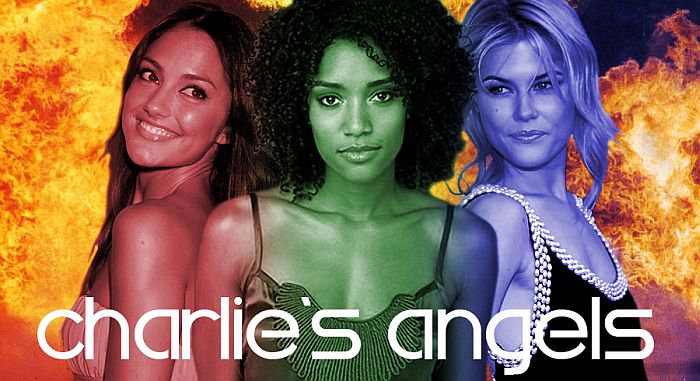
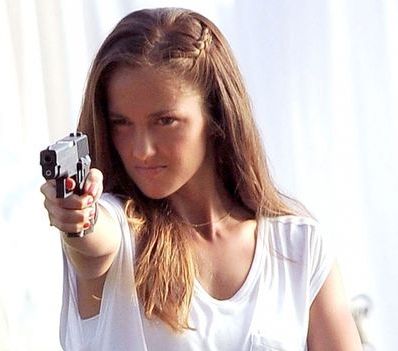 It could perhaps have withstood these barbs, if it hadn’t been for the poor ratings. 8.76 million viewers watched the Sept. 22 premiere, leaving it third in the timeslot, with less than half the audience for CBS and Fox’s offerings. That was disappointing enough, but it lost 19% of its audience the following episode, and by week three, it was down below six million. The death-knell was that, among the 18-49 year old demographic key to advertisers, Angels was on a mere
It could perhaps have withstood these barbs, if it hadn’t been for the poor ratings. 8.76 million viewers watched the Sept. 22 premiere, leaving it third in the timeslot, with less than half the audience for CBS and Fox’s offerings. That was disappointing enough, but it lost 19% of its audience the following episode, and by week three, it was down below six million. The death-knell was that, among the 18-49 year old demographic key to advertisers, Angels was on a mere  Earlier
Earlier 
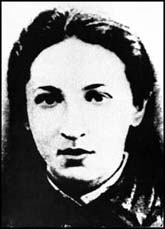 1. In the late 19th century, a number of women were among the active leaders of the Russian nihilist organization Narodnaya Volya (People’s Will), best known for their assassination of Czar Alexander II in 1981. That was organized by a woman, Sophia Perovskaya, with another female member of the Executive Committee, Vera Figner (left) also participating. Four years previously, Vera Zasulich (right) shot and seriously wounded Colonel Theodore Trepov, the hated governor of St. Petersburg.
1. In the late 19th century, a number of women were among the active leaders of the Russian nihilist organization Narodnaya Volya (People’s Will), best known for their assassination of Czar Alexander II in 1981. That was organized by a woman, Sophia Perovskaya, with another female member of the Executive Committee, Vera Figner (left) also participating. Four years previously, Vera Zasulich (right) shot and seriously wounded Colonel Theodore Trepov, the hated governor of St. Petersburg. 3. In Cuba, Celia Sánchez (right, with fellow revolutionary Haydée Santamaría) became one of the earliest members of the 26th of July Movement, joining the struggle after the coup against President Batista in 1952. After Fidel Castro was jailed, she became the rebel leader in the mountainous Sierra region of eastern Cuba, and was called by Castro, “the greatest guerrilla fighter and the most outstanding leader of the Cuban Revolution.” was one of the first women to assemble a combat squad during the revolution[. She was tasked with making all the necessary arrangements throughout the southwest coast region of Cuba, for the Granma landing, and was responsible for organising reinforcements once the revolutionaries landed.
3. In Cuba, Celia Sánchez (right, with fellow revolutionary Haydée Santamaría) became one of the earliest members of the 26th of July Movement, joining the struggle after the coup against President Batista in 1952. After Fidel Castro was jailed, she became the rebel leader in the mountainous Sierra region of eastern Cuba, and was called by Castro, “the greatest guerrilla fighter and the most outstanding leader of the Cuban Revolution.” was one of the first women to assemble a combat squad during the revolution[. She was tasked with making all the necessary arrangements throughout the southwest coast region of Cuba, for the Granma landing, and was responsible for organising reinforcements once the revolutionaries landed. 6. Fusako Shigenobu (left, with colleague Kozo Okamoto) was one of the founders and leaders of the Japanese Red Army. She is now serving 20 years for kidnapping embassy workers during a 1974 Japanese Red Army operation, she is also believed to have played key roles in other hijackings and bomb attacks. Reputedly ordered the murder, by burial alive, of a pregnant woman colleague for being “too bourgeois.” Another left-wing radical, Hiroko Nagata, while acting as vice-chairman of the United Red Army, directed the killing of 14 members of the group by beatings or hypothermia, during a 1972 purge. With friends like that, who needs enemies?
6. Fusako Shigenobu (left, with colleague Kozo Okamoto) was one of the founders and leaders of the Japanese Red Army. She is now serving 20 years for kidnapping embassy workers during a 1974 Japanese Red Army operation, she is also believed to have played key roles in other hijackings and bomb attacks. Reputedly ordered the murder, by burial alive, of a pregnant woman colleague for being “too bourgeois.” Another left-wing radical, Hiroko Nagata, while acting as vice-chairman of the United Red Army, directed the killing of 14 members of the group by beatings or hypothermia, during a 1972 purge. With friends like that, who needs enemies? 9. During their struggle for independence from Spain, Basque separatist group ETA had some infamous women members. These include Maria Dolores Gonzalez (“Yoyez”), who was later assassinated by the group as a reprisal for having left. Also high in their power structure was María Soledad Iparragirre, known as ‘Anboto’, whose exploits allegedly included the murder of a Spanish army Lieutenant and a car bomb explosion against a military bus, that killed seven.
9. During their struggle for independence from Spain, Basque separatist group ETA had some infamous women members. These include Maria Dolores Gonzalez (“Yoyez”), who was later assassinated by the group as a reprisal for having left. Also high in their power structure was María Soledad Iparragirre, known as ‘Anboto’, whose exploits allegedly included the murder of a Spanish army Lieutenant and a car bomb explosion against a military bus, that killed seven.